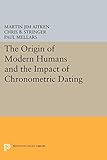The Origin of Modern Humans and the Impact of Chronometric Dating / ed. by Martin Jim Aitken, Paul A. Mellars, Chris B. Stringer.
Material type: TextSeries: Princeton Legacy Library ; 257Publisher: Princeton, NJ : Princeton University Press, [2014]Copyright date: ©1993Edition: Course BookDescription: 1 online resource (256 p.) : 43 illusContent type:
TextSeries: Princeton Legacy Library ; 257Publisher: Princeton, NJ : Princeton University Press, [2014]Copyright date: ©1993Edition: Course BookDescription: 1 online resource (256 p.) : 43 illusContent type: - 9780691604060
- 9781400851553
- 573.2
- GN286 .O75 1993eb
- online - DeGruyter
- Issued also in print.
| Item type | Current library | Call number | URL | Status | Notes | Barcode | |
|---|---|---|---|---|---|---|---|
 eBook
eBook
|
Biblioteca "Angelicum" Pont. Univ. S.Tommaso d'Aquino Nuvola online | online - DeGruyter (Browse shelf(Opens below)) | Online access | Not for loan (Accesso limitato) | Accesso per gli utenti autorizzati / Access for authorized users | (dgr)9781400851553 |
Frontmatter -- Contents -- Outlining the Problem -- Uranium-Series Dating and the Origin of Modern Man -- Luminescence Dating Relevant to Human Origins -- Electron Spin Resonance (ESR) Dating of the Origin of Modern Man -- Pleistocene Geochronology and Palaeothermometry from Protein Diagenesis in Ostrich Eggshells: Implications for the Evolution of Modern Humans -- Evolution of Modern Humans: Evidence From Nuclear DNA Polymorphisms -- New Approaches to Dating Suggest a Recent Age for the Human mtDNA Ancestor -- Southern Africa and Modern Human Origins -- Recent Human Evolution in Northwestern Africa -- The Role of Western Asia in Modern Human Origins -- African and Asian Perspectives on the Origins of Modern Humans -- Reconstructing Recent Human Evolution -- Archaeology and the Population-Dispersal Hypothesis of Modern Human Origins in Europe -- Recent Human Evolution in East Asia and Australasia -- Models and Realities in Modern Human Origins: The African Fossil Evidence
restricted access online access with authorization star
http://purl.org/coar/access_right/c_16ec
This volume of papers delivered to The Royal Society in February of 1992 explores the debate over the "single center" hypothesis of human origins versus "multi-regional evolution." Over the last five years there has been growing support for a recent "Out of Africa" origin of modern humans--based on fresh interpretations of the palaeoanthropological and archaeological evidence, new applications of physical dating techniques to important sites, and a greatly increased genetic data base on recent human variation and its geographical patterning. But there has also been a parallel growth of doubts about interpretations of the new evidence from some workers. This book provides a review of recent progress and allows some of these doubts to be aired and discussed.In addition to the editors, the contributors are O. Bar-Yosef, A. M. Bowcock, P. Brown, H. J. Deacon, L. L. Cavalli-Sforza, J. D. Clark, R. Grün, J.-J. Hublin, A. A. Lin, G. H. Miller, J. L. Mountain, H. P. Schwarcz, N. J. Shackleton, F. H. Smith, and M. Stoneking.Originally published in 1993.The Princeton Legacy Library uses the latest print-on-demand technology to again make available previously out-of-print books from the distinguished backlist of Princeton University Press. These editions preserve the original texts of these important books while presenting them in durable paperback and hardcover editions. The goal of the Princeton Legacy Library is to vastly increase access to the rich scholarly heritage found in the thousands of books published by Princeton University Press since its founding in 1905.
Issued also in print.
Mode of access: Internet via World Wide Web.
In English.
Description based on online resource; title from PDF title page (publisher's Web site, viewed 30. Aug 2021)


